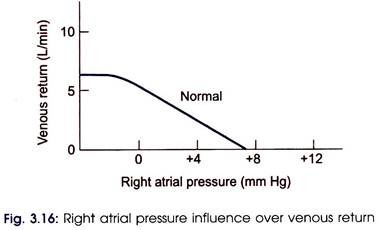ADVERTISEMENTS:
The following points highlight the top eight factors affecting venous return. The factors are: 1. Pressure Gradient 2. Vis-a-Tergo 3. Vis-a-Fronte 4. Skeletal Muscle Pump 5. Thoracic Pump 6. Abdominal Pump 7. Venomotor Tone 8. Posture and Gravity.
Factor # 1. Pressure Gradient:
The pressure in the right atria (central venous pressure) into which the superior and inferior vena cavae open is around 0 mm Hg. In the peripheral veins, the pressure is around 8 mm Hg and the pressure in the veins nearer to the heart goes on decreasing.
In the right atrium, the pressure (central venous pressure) is almost 0 mm Hg. So the pressure gradient along the veins towards the right side of the heart is responsible for the flow of blood into right atrium. When central venous pressure becomes positive as seen in pulmonary hypertension, the gradient is reduced. Hence there will be decreased venous return (Fig. 3.16).
Factor # 2. Vis-a-Tergo (force acting from behind):
The contraction of the left ventricle creates a pressure that pushes blood from behind all along the vascular tree throughout the body. This pressure from the left side of heart which is ultimately responsible for pushing of blood from behind towards the right side of heart is called vis-a-tergo. This is proved by stimulating the vagus. The heart stops contracting and venous return is reduced.
Factor # 3. Vis-a-Fronte (force acting from front):
ADVERTISEMENTS:
The pressure in the right atrium is normally around 0 mm Hg. During ventricular contraction, the atrioventricular ring is pulled down. As a result of this, the atria get expanded.
This creates a negative pressure in right atrium and the negative pressure is also created during sudden rush of blood from atria to ventricle. This negative pressure exerts suction effect on the great veins and draws blood into the atrium. This is known as vis-a-fronte.
Factor # 4. Skeletal Muscle Pump:
The veins are arranged in between the skeletal muscle fibers and are arranged parallel to skeletal muscle fibers. So when the muscle contracts the veins get squeezed. Due to the compressor effect of the muscle fibers on the vein, blood is made to flow through them.
ADVERTISEMENTS:
However, blood is made to flow in the direction of heart due to the presence of valves in veins, which prevent back flow. If the skeletal muscles do not contract, there will be pooling of blood especially in the lower parts of body in the erect posture. This is because of two reasons, namely
a. No activity of muscle pumps.
b. The gravitational force acts as counter-force for venous return and try to retain as much blood in the dependent parts of body. In soldiers, prolonged standing at attention, venous return is decreased and in some of the cases it may fall to zero. This decreases cardiac output and hence the person may collapse.
Factor # 5. Thoracic Pump:
During inspiration, the intrapleural pressure becomes more negative. A simultaneous increase of pressure in the abdomen and a more negative pressure in thorax, increase the pressure gradient for flow of blood towards the heart from the abdomen. Hence venous return is more during inspiratory phase when compared to expiratory phase during which the intrapleural pressure is less negative.
Factor # 6. Abdominal Pump:
Normally, veins present in the splanchnic region act as reservoir for blood. When the abdominal muscles contract, there will be increase of intra-abdominal pressure and hence compression of veins occurs in the abdominal region. This increases venous return by increasing the gradient towards the thoracic cavity (heart).
Factor # 7. Venomotor Tone:
The constant excitatory influence by sympathetic nerves on the smooth muscle of veins is called venomotor tone. Because of this, the walls of the veins remain in a partially contracted state even under resting condition. When the venomotor tone is increased, the capacity of veins decreases. This increases the venous return.
Factor # 8. Posture and Gravity:
As such the pressure in the veins is very less. When gravitational force acts on the lower parts of body especially in the erect posture, it will decrease the venous return from the lower limbs. The gravitational force tries to pull down blood from the dependent parts of the body.
This keeps on increasing the pressure in veins in the dependent parts of body. In addition to this, pulling down of blood in the arterial compartment due to gravitational force, increases the hydrostatic pressure in the capillaries. The overall effect will be more fluid transudation from the intra-vascular compartment to interstitial spaces.
ADVERTISEMENTS:
This will give rise to edema. This may be one of the reasons for swelling of legs in long-distance flights; wherein prolonged erect posture in the absence of muscular contractions will lead to swelling of legs. The stasis of blood in the venous compartment, at times may lead to intravascular clotting and this is known as deep vein thrombosis.
When a person is in recumbent posture, the gravitational force acts equally on all the parts of body. This is going to facilitate venous return. People who have been standing almost stationary for prolonged time, have tendency to fall unconscious is because of decreased venous return.
This decreases the cardiac output and hence reduces blood flow to brain. The falling down of such people in fact is a natural defence mechanism to facilitate venous return and restoration of blood flow to brain.

